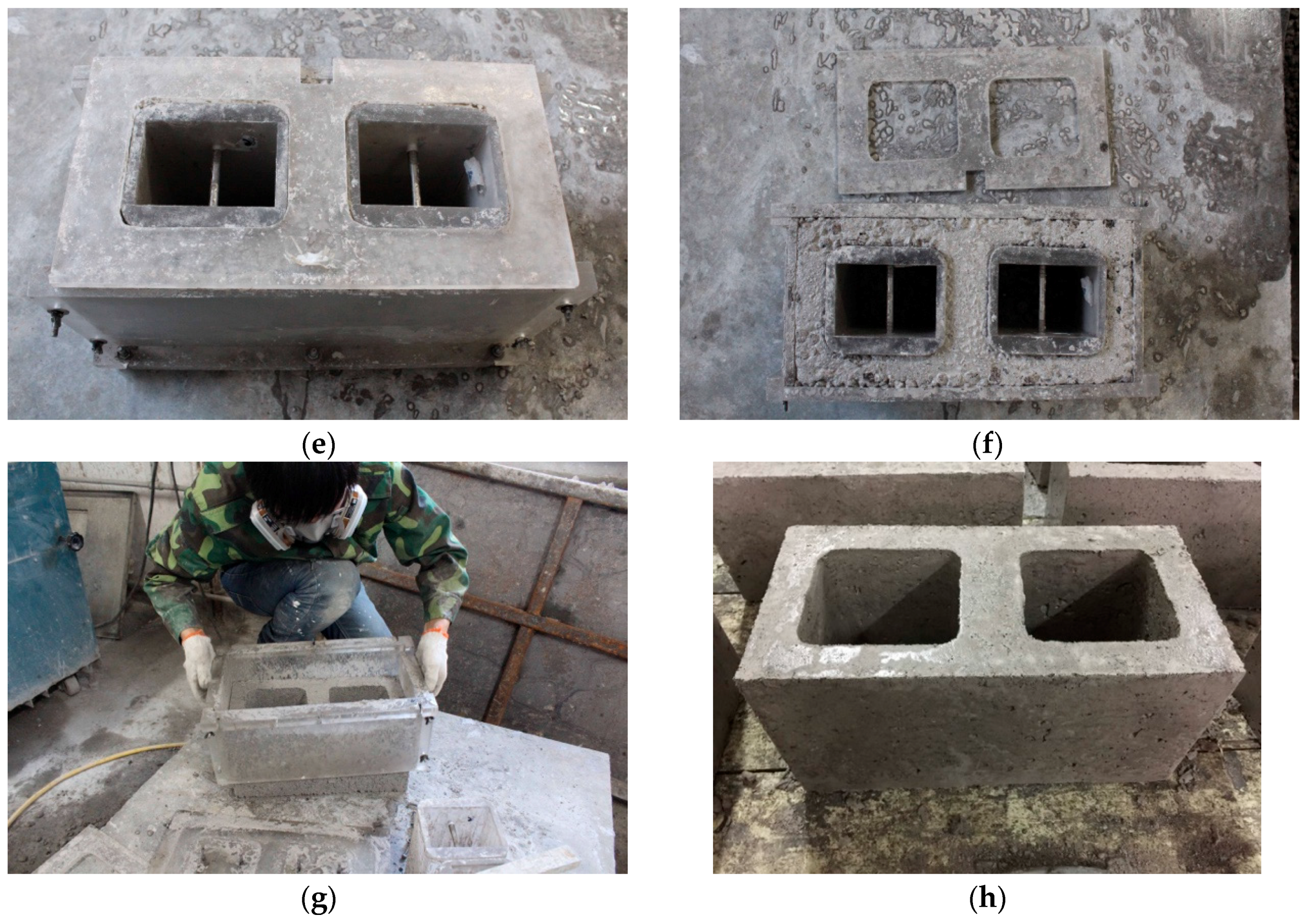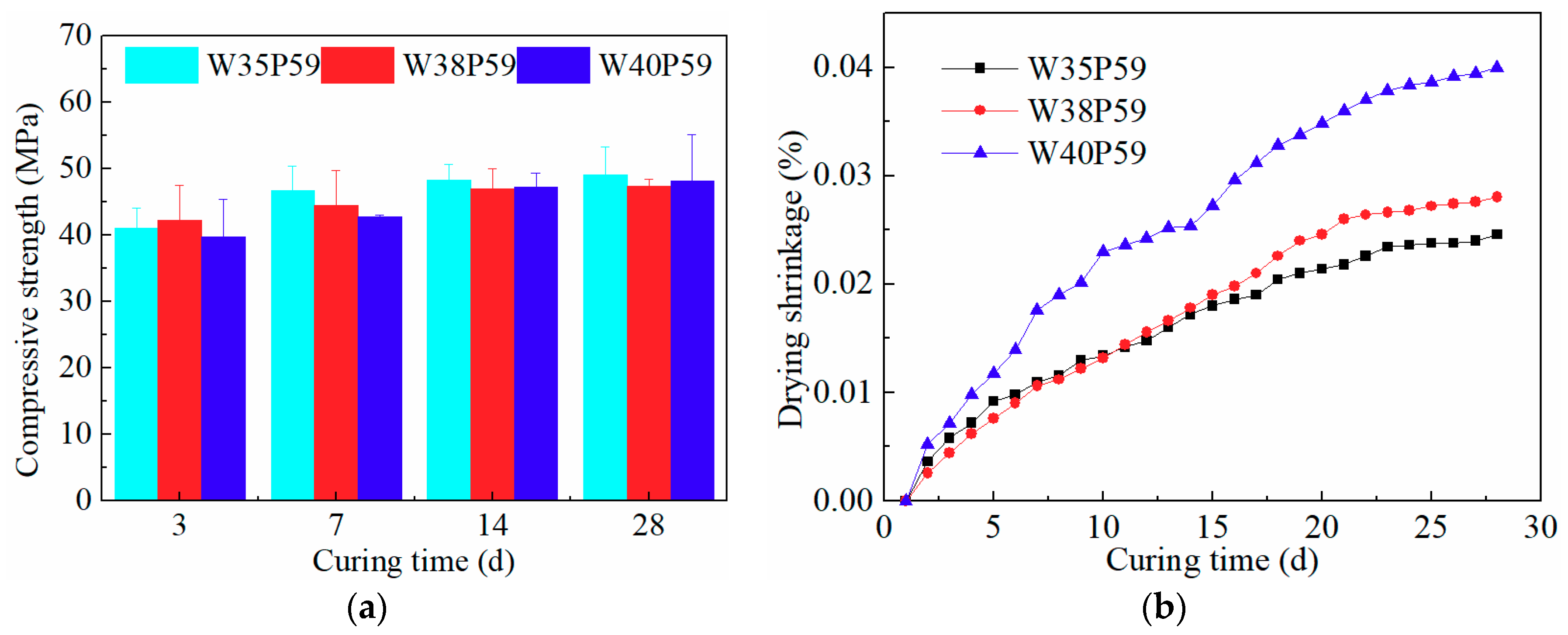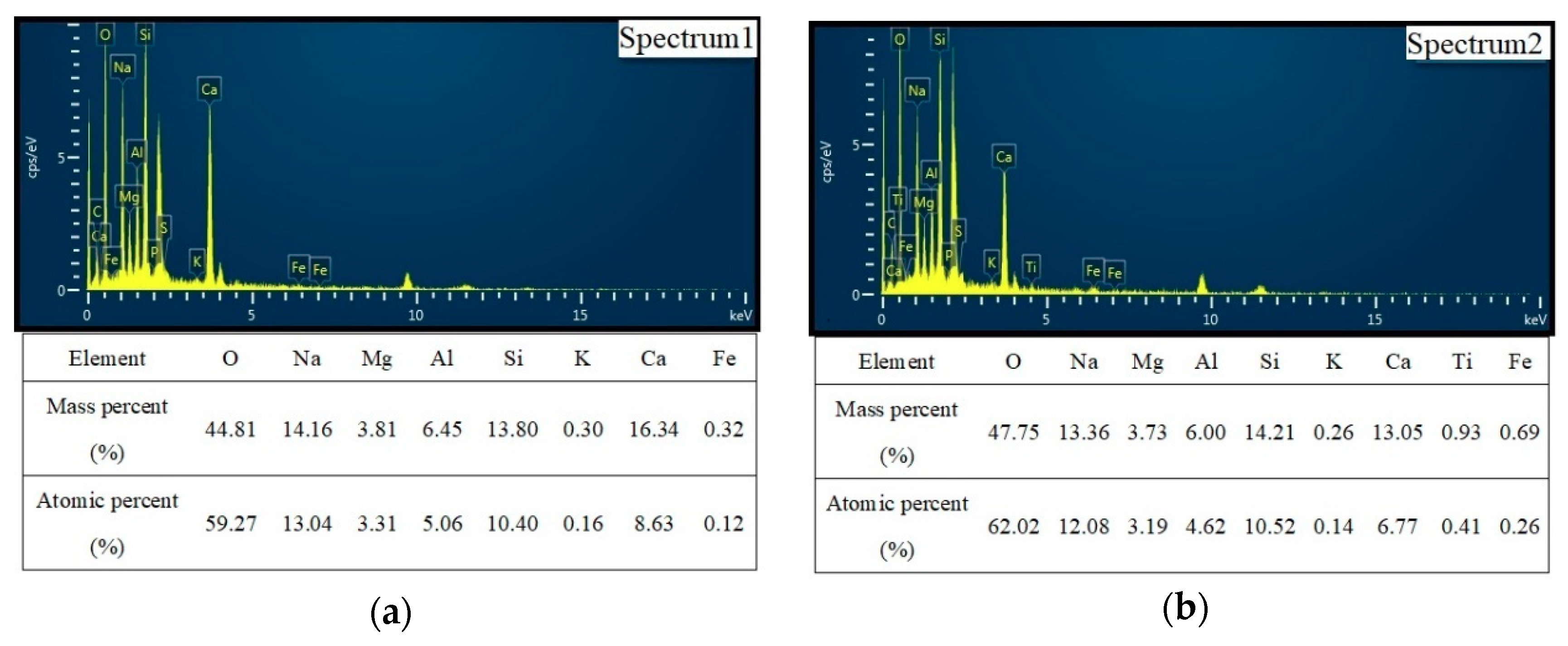Use of Industrial Waste Slag in Alkali-Activated Slag Ceramsite Concrete Hollow Blocks
Abstract
:1. Introduction
2. Materials and Methods
2.1. Materials
2.1.1. Alkaline Activator
2.1.2. Blast Furnace Slag
2.1.3. Coarse Aggregate and Fine Aggregate
2.2. Evaluated Mixes
2.2.1. Mix Proportions
2.2.2. Mix Test Specimen Preparation
2.3. Preparation of Concrete Block Specimens
2.4. Test Procedures
2.4.1. Compressive Strength of AASC
2.4.2. Drying Shrinkage of AASC
2.4.3. Compressive and Flexural Strengths of AASCHB Specimens
2.4.4. Water Absorption and Moisture Content of AASCHB Specimens
2.4.5. Scanning Electron Microscopy with Energy-Dispersive Spectrometry
3. Results and Discussion
3.1. Compressive Strength and Drying Shrinkage of AASC
3.1.1. Effects of the Water-to-Slag Ratio
3.1.2. Effect of the Sand Ratio
3.1.3. Effect of Alkaline Activator
3.2. Performance of AASCHB Specimens
3.3. Microstructure
4. Conclusions
- (1)
- The compressive strength of alkali-activated slag concrete decreased with increasing water-to-slag ratio, silicate modulus, and Na2O content. The effects of the silicate modulus and Na2O content on the mechanical performance were quite obvious, and an optimum sand ratio for providing maximum compressive strength was observed in the range of 0.54–0.68.
- (2)
- The drying shrinkage of alkali-activated slag concrete increased as the water-to-slag ratio, silicate modulus, and Na2O content increased and as the sand ratio decreased.
- (3)
- The optimum mix for preparing the alkali-activated slag concrete hollow block contained a water-to-slag ratio of 0.35, sand ratio of 0.64, silicate modulus of 1.2, and Na2O content of 8%, providing optimal workability, high compressive strength, and low drying shrinkage. The hydration products of the selected mix were close-grained and symmetrical, which provided improved compressive strength.
- (4)
- The alkali-activated slag concrete hollow block made of Mix M1.2N8 can be classified as strength grade of MU15 and is appropriate for use as a load-bearing hollow concrete block.
Author Contributions
Funding
Acknowledgments
Conflicts of Interest
References
- Puertas, F.; Martínez-Ramírez, S.; Alonso, S.; Vázquez, T. Alkali-activated fly ash/slag cements: Strength behaviour and hydration products. Cem. Concr. Res. 2000, 30, 1625–1632. [Google Scholar] [CrossRef]
- Jiao, Z.; Wang, Y.; Zheng, W.; Huang, W. Effect of dosage of sodium carbonate on the strength and drying shrinkage of sodium hydroxide based alkali-activated slag paste. Constr. Build. Mater. 2018, 179, 11–24. [Google Scholar] [CrossRef]
- Živica, V. Effects of type and dosage of alkaline activator and temperature on the properties of alkali-activated slag mixtures. Constr. Build. Mater. 2007, 21, 1463–1469. [Google Scholar] [CrossRef]
- Parronrubio, M.E.; Perezgarcía, F.; Gonzalezherrera, A.; Rubiocintas, M.D. Concrete properties comparison when substituting a 25% cement with slag from different provenances. Materials 2018, 11, 1029. [Google Scholar] [CrossRef]
- Berndt, M.L. Properties of sustainable concrete containing fly ash, slag and recycled concrete aggregate. Constr. Build. Mater. 2009, 23, 2606–2613. [Google Scholar] [CrossRef]
- Provis, J.L.; Palomo, A.; Shi, C. Advances in understanding alkali-activated materials. Cem. Concr. Res. 2015, 78, 110–125. [Google Scholar] [CrossRef] [Green Version]
- Puertas, F.; González-Fonteboa, B.; González-Taboada, I.; Alonso, M.M.; Torres-Carrasco, M.; Rojo, G.; Martínez-Abella, F. Alkali-activated slag concrete: Fresh and hardened behaviour. Cem. Concr. Compos. 2018, 85, 22–31. [Google Scholar] [CrossRef]
- Bernal, S.A.; Mejía de Gutiérrez, R.; Pedraza, A.L.; Provis, J.L.; Rodriguez, E.D.; Delvasto, S. Effect of binder content on the performance of alkali-activated slag concretes. Cem. Concr. Res. 2011, 41, 1–8. [Google Scholar] [CrossRef]
- Fu, Y.; Cai, L.; Wu, Y. Freeze—Thaw cycle test and damage mechanics models of alkali-activated slag concrete. Constr. Build. Mater. 2011, 25, 3144–3148. [Google Scholar] [CrossRef]
- Li, Z.; Li, S. Carbonation resistance of fly ash and blast furnace slag based geopolymer concrete. Constr. Build. Mater. 2018, 163, 668–680. [Google Scholar] [CrossRef]
- Aydin, S.; Baradan, B. Effect of activator type and content on properties of alkali-activated slag mortars. Compos. Part B Eng. 2014, 57, 166–172. [Google Scholar] [CrossRef]
- Jiao, Z.; Wang, Y.; Zheng, W.; Huang, W. Pottery sand as fine aggregate for preparing alkali-activated slag mortar. Adv. Mater. Sci. Eng. 2018, 2018. [Google Scholar] [CrossRef]
- Kovtun, M.; Kearsley, E.P.; Shekhovtsova, J. Chemical acceleration of a neutral granulated blast-furnace slag activated by sodium carbonate. Cem. Concr. Res. 2015, 72, 1–9. [Google Scholar] [CrossRef] [Green Version]
- Keulen, A.; Yu, Q.L.; Zhang, S.; Grünewald, S. Effect of admixture on the pore structure refinement and enhanced performance of alkali-activated fly ash-slag concrete. Constr. Build. Mater. 2018, 162, 27–36. [Google Scholar] [CrossRef]
- Wang, C.-C.; Wang, H.-Y.; Chen, B.-T.; Peng, Y.-C. Study on the engineering properties and prediction models of an alkali-activated mortar material containing recycled waste glass. Constr. Build. Mater. 2017, 132, 130–141. [Google Scholar] [CrossRef]
- Wang, W.-C.; Wang, H.-Y.; Lo, M.-H. The fresh and engineering properties of alkali activated slag as a function of fly ash replacement and alkali concentration. Constr. Build. Mater. 2015, 84, 224–229. [Google Scholar] [CrossRef]
- Chi, M. Effects of dosage of alkali-activated solution and curing conditions on the properties and durability of alkali-activated slag concrete. Constr. Build. Mater. 2012, 35, 240–245. [Google Scholar] [CrossRef]
- Ben Haha, M.; Le Saout, G.; Winnefeld, F.; Lothenbach, B. Influence of activator type on hydration kinetics, hydrate assemblage and microstructural development of alkali activated blast-furnace slags. Cem. Concr. Res. 2011, 41, 301–310. [Google Scholar] [CrossRef]
- Duran Atiş, C.; Bilim, C.; Çelik, Ö.; Karahan, O. Influence of activator on the strength and drying shrinkage of alkali-activated slag mortar. Constr. Build. Mater. 2009, 23, 548–555. [Google Scholar] [CrossRef]
- Collins, F.; Sanjayan, J.G. Effect of pore size distribution on drying shrinkage of alkali-activated slag concrete. Cem. Concr. Res. 2000, 30, 1401–1406. [Google Scholar] [CrossRef]
- Zhang, W.; Zakaria, M.; Hama, Y. Influence of aggregate materials characteristics on the drying shrinkage properties of mortar and concrete. Constr. Build. Mater. 2013, 49, 500–510. [Google Scholar] [CrossRef] [Green Version]
- Cao, J.; Chung, D.D.L. Microstructural effect of the shrinkage of cement-based materials during hydration, as indicated by electrical resistivity measurement. Cem. Concr. Res. 2004, 34, 1893–1897. [Google Scholar] [CrossRef]
- Ravikumar, D.; Neithalath, N. Effects of activator characteristics on the reaction product formation in slag binders activated using alkali silicate powder and NaOH. Cem. Concr. Compos. 2012, 34, 809–818. [Google Scholar] [CrossRef]
- Rashad, A.M.; Zeedan, S.R.; Hassan, A.A. Influence of the activator concentration of sodium silicate on the thermal properties of alkali-activated slag pastes. Constr. Build. Mater. 2016, 102, 811–820. [Google Scholar] [CrossRef]
- Karakoç, M.B.; Türkmen, İ.; Maraş, M.M.; Kantarci, F.; Demirboğa, R.; Uğur Toprak, M. Mechanical properties and setting time of ferrochrome slag based geopolymer paste and mortar. Constr. Build. Mater. 2014, 72, 283–292. [Google Scholar] [CrossRef]
- Komnitsas, K.; Zaharaki, D.; Perdikatsis, V. Effect of synthesis parameters on the compressive strength of low-calcium ferronickel slag inorganic polymers. J. Hazard. Mater. 2009, 161, 760–768. [Google Scholar] [CrossRef] [PubMed]
- Thomas, R.J.; Lezama, D.; Peethamparan, S. On drying shrinkage in alkali-activated concrete: Improving dimensional stability by aging or heat-curing. Cem. Concr. Res. 2017, 91, 13–23. [Google Scholar] [CrossRef]
- Bissonnette, B.; Pierre, P.; Pigeon, M. Influence of key parameters on drying shrinkage of cementitious materials. Cem. Concr. Res. 1999, 29, 1655–1662. [Google Scholar] [CrossRef]
- Dahmen, J.; Kim, J.; Ouellet-Plamondon, C.M. Life cycle assessment of emergent masonry blocks. J. Clean. Prod. 2018, 171, 1622–1637. [Google Scholar] [CrossRef]
- Munoz, J.F.; Easton, T.; Dahmen, J. Using alkali-activated natural aluminosilicate minerals to produce compressed masonry construction materials. Constr. Build. Mater. 2015, 95, 86–95. [Google Scholar] [CrossRef]
- Wang, W.-C.; Chen, B.-T.; Wang, H.-Y.; Chou, H.-C. A study of the engineering properties of alkali-activated waste glass material (AAWGM). Constr. Build. Mater. 2016, 112, 962–969. [Google Scholar] [CrossRef]
- Wang, S.-D.; Scrivener, K.L.; Pratt, P.L. Factors affecting the strength of alkali-activated slag. Cem. Concr. Res. 1994, 24, 1033–1043. [Google Scholar] [CrossRef]
- Manjunath, R.; Narasimhan, M.C. An experimental investigation on self-compacting alkali activated slag concrete mixes. J. Build. Eng. 2018, 17, 1–12. [Google Scholar] [CrossRef]
- Allahverdi, A.; Kani, E.N.; Yazdanipour, M. Effects of blast-furnace slag on natural pozzolan-based geopolymer cement. Ceram. Sil. 2011, 55, 68–78. [Google Scholar]
- Singh, B.; Rahman, M.R.; Paswan, R.; Bhattacharyya, S.K. Effect of activator concentration on the strength, ITZ and drying shrinkage of fly ash/slag geopolymer concrete. Constr. Build. Mater. 2016, 118, 171–179. [Google Scholar] [CrossRef]
- Bazant, Z.P. Prediction of concrete creep and shrinkage: Past, present and future. Nucl. Eng. Des. 2001, 203, 27–38. [Google Scholar] [CrossRef]
- Han, M.Y.; Lytton, R.L. Theoretical prediction of drying shrinkage of concrete. J. Mater. Civ. Eng. 1995, 7, 204–207. [Google Scholar] [CrossRef]
- Wang, X.F.; Fang, C.; Kuang, W.Q.; Li, D.W.; Han, N.X.; Xing, F. Experimental investigation on the compressive strength and shrinkage of concrete with pre-wetted lightweight aggregates. Constr. Build. Mater. 2017, 155, 867–879. [Google Scholar] [CrossRef]
- Ji, T.; Zheng, D.-D.; Chen, X.-F.; Lin, X.-J.; Wu, H.-C. Effect of prewetting degree of ceramsite on the early-age autogenous shrinkage of lightweight aggregate concrete. Constr. Build. Mater. 2015, 98, 102–111. [Google Scholar] [CrossRef]
- GarcãA, J.I.E.; Campos-Venegas, K.; Gorokhovsky, A.; Fernãndez, A. Cementitious composites of pulverised fuel ash and blast furnace slag activated by sodium silicate: Effect of Na2O concentration and modulus. Br. Ceram. Trans. 2006, 105, 201–208. [Google Scholar]
- Cihangir, F.; Ercikdi, B.; Kesimal, A.; Deveci, H.; Erdemir, F. Paste backfill of high-sulphide mill tailings using alkali-activated blast furnace slag: Effect of activator nature, concentration and slag properties. Miner. Eng. 2015, 83, 117–127. [Google Scholar] [CrossRef]
- Wang, W.-C.; Wang, H.-Y.; Tsai, H.-C. Study on engineering properties of alkali-activated ladle furnace slag geopolymer. Constr. Build. Mater. 2016, 123, 800–805. [Google Scholar] [CrossRef]
- Song, S.J.; Jennings, H.M. Pore solution chemistry of alkali-activated ground granulated blast-furnace slag. Cem. Concr. Res. 1999, 29, 159–170. [Google Scholar] [CrossRef]
- Deb, P.S.; Nath, P.; Sarker, P.K. Drying shrinkage of slag blended fly ash geopolymer concrete cured at room temperature. Proc. Eng. 2015, 125, 594–600. [Google Scholar] [CrossRef]
- Chi, M.; Huang, R. Binding mechanism and properties of alkali-activated fly ash/slag mortars. Constr. Build. Mater. 2013, 40, 291–298. [Google Scholar] [CrossRef]
- Provis, J.L.; Myers, R.J.; White, C.E.; Rose, V.; van Deventer, J.S.J. X-ray microtomography shows pore structure and tortuosity in alkali-activated binders. Cem. Concr. Res. 2012, 42, 855–864. [Google Scholar] [CrossRef]
- Bakharev, T.; Sanjayan, J.G.; Cheng, Y.B. Alkali activation of Australian slag cements. Cem. Concr. Res. 1999, 29, 113–120. [Google Scholar] [CrossRef]
- Richardson, I.G. The nature of C-S-H in hardened cements. Cem. Concr. Res. 1999, 29, 1131–1147. [Google Scholar] [CrossRef]
- Brough, A.R.; Atkinson, A. Sodium silicate-based, alkali-activated slag mortars: Part I. Strength, hydration and microstructure. Cem. Concr. Res. 2002, 32, 865–879. [Google Scholar] [CrossRef]
- Pacheco-Torgal, F.; Castro-Gomes, J.; Jalali, S. Alkali-activated binders: A review: Part 1. Historical background, terminology, reaction mechanisms and hydration products. Constr. Build. Mater. 2008, 22, 1305–1314. [Google Scholar] [CrossRef] [Green Version]
- Wang, S.-D.; Scrivener, K.L. Hydration products of alkali activated slag cement. Cem. Concr. Res. 1995, 25, 561–571. [Google Scholar] [CrossRef]
- Kiventerä, J.; Lancellotti, I.; Catauro, M.; Poggetto, F.D.; Leonelli, C.; Illikainen, M. Alkali activation as new option for gold mine tailings inertization. J. Clean. Prod. 2018, 187, 76–84. [Google Scholar] [CrossRef]
- Gu, Y.-m.; Fang, Y.-h.; You, D.; Gong, Y.-f.; Zhu, C.-h. Properties and microstructure of alkali-activated slag cement cured at below- and about-normal temperature. Constr. Build. Mater. 2015, 79, 1–8. [Google Scholar] [CrossRef]











| Oxide | SiO2 | Al2O3 | CaO | Fe2O3 | K2O | MgO | Na2O | SO3 | P2O5 |
|---|---|---|---|---|---|---|---|---|---|
| Slag | 36.08 | 10.22 | 42.01 | 0.33 | 0.71 | 8.27 | 0.41 | 1.95 | 0.02 |
| Oxide | SiO2 | Al2O3 | CaO | Fe2O3 | K2O | MgO | Na2O | Others |
|---|---|---|---|---|---|---|---|---|
| Pottery sand | 62.12 | 16.32 | 3.26 | 7.84 | 1.25 | 2.04 | 1.97 | 5.2 |
| Mix 1 | Water Glass | NaOH | H2O | Slag | Pottery Sand | Ceramsite (10–16 mm) | Ceramsite (5–10 mm) |
|---|---|---|---|---|---|---|---|
| W35P59 | 289.9 | 64.5 | 168.5 | 1000 | 1511.6 | 732.6 | 314.0 |
| W38P59 | 289.9 | 64.5 | 198.5 | 1000 | 1511.6 | 732.6 | 314.0 |
| W40P59 | 289.9 | 64.5 | 218.5 | 1000 | 1511.6 | 732.6 | 314.0 |
| W35P54 | 289.9 | 64.5 | 168.5 | 1000 | 1322.7 | 793.6 | 340.1 |
| W35P64 (M1.2N8) | 289.9 | 64.5 | 168.5 | 1000 | 1700.6 | 671.5 | 287.8 |
| W35P68 | 289.9 | 64.5 | 168.5 | 1000 | 1889.5 | 610.5 | 261.6 |
| M1.2N6 | 217.4 | 48.4 | 213.9 | 1000 | 1700.6 | 671.5 | 287.8 |
| M1.2N10 | 362.3 | 80.6 | 123.2 | 1000 | 1700.6 | 671.5 | 287.8 |
| M1.4N6 | 253.2 | 43.5 | 194.1 | 1000 | 1700.6 | 671.5 | 287.8 |
| M1.4N8 | 338.2 | 58.1 | 142.1 | 1000 | 1700.6 | 671.5 | 287.8 |
| M1.4N10 | 422.7 | 72.6 | 90.2 | 1000 | 1700.6 | 671.5 | 287.8 |
| M1.6N6 | 289.9 | 38.7 | 174.3 | 1000 | 1700.6 | 671.5 | 287.8 |
| M1.6N8 | 386.5 | 51.6 | 115.8 | 1000 | 1700.6 | 671.5 | 287.8 |
| M1.6N10 | 483.1 | 64.5 | 57.2 | 1000 | 1700.6 | 671.5 | 287.8 |
| Properties | Values | Mean Value | SD | CV |
|---|---|---|---|---|
| Compressive strength (MPa) | 17.5 | 17.2 | 1.27 | 0.074 |
| 15.4 | ||||
| 18.7 | ||||
| 16.6 | ||||
| 17.9 | ||||
| Flexural strength (MPa) | 1.3 | 1.2 | 0.10 | 0.083 |
| 1.2 | ||||
| 1.1 | ||||
| 1.2 | ||||
| 1.1 | ||||
| Water absorption (%) | 10.43 | 9.95 | 0.53 | 0.054 |
| 9.38 | ||||
| 10.04 | ||||
| Moisture content (%) | 6.24 | 6.19 | 0.05 | 0.009 |
© 2018 by the authors. Licensee MDPI, Basel, Switzerland. This article is an open access article distributed under the terms and conditions of the Creative Commons Attribution (CC BY) license (http://creativecommons.org/licenses/by/4.0/).
Share and Cite
Jiao, Z.; Wang, Y.; Zheng, W.; Huang, W.; Zhou, X. Use of Industrial Waste Slag in Alkali-Activated Slag Ceramsite Concrete Hollow Blocks. Appl. Sci. 2018, 8, 2358. https://doi.org/10.3390/app8122358
Jiao Z, Wang Y, Zheng W, Huang W, Zhou X. Use of Industrial Waste Slag in Alkali-Activated Slag Ceramsite Concrete Hollow Blocks. Applied Sciences. 2018; 8(12):2358. https://doi.org/10.3390/app8122358
Chicago/Turabian StyleJiao, Zhenzhen, Ying Wang, Wenzhong Zheng, Wenxuan Huang, and Xianyu Zhou. 2018. "Use of Industrial Waste Slag in Alkali-Activated Slag Ceramsite Concrete Hollow Blocks" Applied Sciences 8, no. 12: 2358. https://doi.org/10.3390/app8122358





